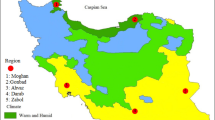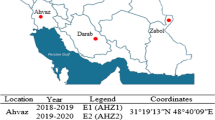Abstract
The development of genotypes with adaptation to a wide range of environments is one of the most important goals of plant breeding programs. In order to compare nonparametric stability measures and to identify promising high-yield and stable barley (Hordeum vulgare L.), 20 barley genotypes selected from the Iran/ICARDA joint project and grown in nine environments during 2009-11 in Iran. Four nonparametric statistical tests of significance for genotype × environment (GE) interaction and 10 nonparametric measures of stability were used to identify stable genotypes in nine environments. Results of nonparametric tests of G×E interaction (Kubinger, Hildebrand, and Kroon/ Laan) and a combined ANOVA across environments, indicated the presence of both crossover and non-crossover interactions. Also, only TOP and rank-sum values were positively associated with high yield. Thus, in the simultaneous selection for high yield and stability, only the rank-sum and TOP methods were useful in terms of the principal component analysis results, and correlation analysis of nonparametric stability statistics and yield. According to these stability parameters (TOP and rank-sum), three genotypes (G13, G12, and G17) were the most stable for grain yield. The results also revealed that based on nonparametric test results, stability could be classified into three groups, according to agronomic and biological concepts of stability.
Similar content being viewed by others
References
Adugna W, Labuschagne M. 2003. Parametric and nonparametric measures of phenotypic stability in linseed (Linum usitatissimum L.). Euphytica 129: 211–218
Ahmadi A, Joudi M, Janmohammadi M. 2009. Late defoliation and wheat yield: little evidence of post-anthesis source limitation. Field Crop. Res. 113: 90–93
Baker R. 1990. Crossover genotype-environmental interaction in spring wheat. Genotype-by-environment interaction and plant breeding, Louisiana State University Agricultural Center. Baton Rouge, LA, pp. 42–51
Bavei V, Vaezi B, Abdipour M, Jalal Kamali M, Roustaii R. 2011. Screening of tolerant spring barleys for terminal heat stress: Different importance of yield components in barleys with different row type. Int. J. Plant Breed Genet. 5(3): 175–193
Becker H, Leon J. 1988. Stability analysis in plant breeding. Plant Breed. 101: 1–23
Bishnoi S. 2015. Statistical models for evaluating genotype × environment interaction in wheat (Triticum aestivum L.). CCSHAU
Bortz J, Lienert GA, Boehnke K. 2008. Verteilungsfreie methoden in der biostatistik. Springer-Verlag
Ceccarelli S. 1994. Specific adaptation and breeding for marginal conditions, Breeding Fodder Crops for Marginal Conditions. Springer, pp 101–127
Comstock R, Moll RH. 1963. Genotype-environment interactions. Stat. Genet. Plant Breed. 982: 164–196
FAO. 2015. Production year book. Food and Agricultural Organization
Farshadfar E, Mahmudi N, Sheibanirad A. 2014. Nonparametric methods for interpreting genotype × environment interaction in bread wheat genotypes. J. Bio. Env. Sci. 4: 55–62
Farshadfar E, Sabaghpour SH, Zali H. 2012. Comparison of parametric and non-parametric stability statistics for selecting stable chickpea (Cicer arietinum L.) genotypes under diverse environments. Aust. J. Crop Sci. 6(3): 514–524
Flores F, Moreno M, Cubero J. 1998. A comparison of univariate and multivariate methods to analyze G× E interaction. Field Crop. Res. 56: 271–286
Fox P, Skovmand B, Thompson B, Braun HJ., Cormier R. 1990. Yield and adaptation of hexaploid spring triticale. Euphytica 47: 57–64
Hasanuzzaman M, Shabala L, Brodribb TJ, Zhou M, Shabala S. 2017. Assessing the suitability of various screening methods as a proxy for drought tolerance in barley. Funct. Plant Biol. 44: 253–266
Hildebrand H. 1980. Asymptotisch verteilungsfreie Rangtests in linearen Modellen, Biometrie—heute und morgen. Springer, pp 344–349
Huehn M. 1979. Beitrage zur erfassung der phanotypischen stabilitat. EDV. Exp. Med. Biol. 10: 112–117
Huehn M. 1990. Nonparametric measures of phenotypic stability. Part 1: Theory. Euphytica. 47: 189–194
Hühn M, Léon J. 1995. Nonparametric analysis of cultivar performance trials: experimental results and comparison of different procedures based on ranks. Agron. J. 87: 627–632
Kang M. 1988. A rank-sum method for selecting high-yielding, stable corn genotypes. Cereal Res. Commun. 16: 113–115
Kang MS. 1990. Genotype-by-environment interaction and plant breeding. Louisiana State University
Khalili M, Pour-Aboughadareh A. 2016. Parametric and nonparametric measures for evaluating yield stability and adaptability in barley doubled haploid lines. J. Agric. Sci. and Technol. 18: 789–803
Kroon JD, Laan P. 1981. Distribution-free test procedures in two-way layouts; a concept of rank-interaction. Stat. Neerl. 35: 189–213
Kubinger KD. 1986. A note on non-parametric tests for the interaction in two-way layouts. Biom. J. 28: 67–72
Lin CS, Binns MR, Lefkovitch LP. 1986. Stability analysis: where do we stand? Crop Sci. 26: 894–900
Mekbib F. 2003. Yield stability in common bean (Phaseolus vulgaris L.) genotypes. Euphytica 130: 147–153
Meng Y, Ren P, Ma X, Li B, Bao Q, Zhang H, Wang J, Bai J, Wang H. 2016. GGE Biplot-based evaluation of yield performance of barley genotypes across different environments in China. J. Agr. Sci. Tech. 18: 533–543
Mohammadi R. 2016. Efficiency of yield-based drought tolerance indices to identify tolerant genotypes in durum wheat. Euphytica 211: 71–89
Mohammadi R, Abdulahi A, Haghparast R, Aghaee M, Rostaee M. 2007a. Nonparametric methods for evaluating of winter wheat genotypes in multi-environment trials. World J. Agric. Sci. 3: 137–242
Mohammadi R, Abdulahi A, Haghparast R, Armion M. 2007b. Interpreting genotype× environment interactions for durum wheat grain yields using nonparametric methods. Euphytica 157: 239–251
Mohammadi R, Amri A. 2008. Comparison of parametric and non-parametric methods for selecting stable and adapted durum wheat genotypes in variable environments. Euphytica 159: 419–432
Mortazavian, SMM, Azizinia S. 2014. Nonparametric stability analysis in multi-environment trial of canola. Turk. J. Field Crops. 19(1): 108–117
Mut Z, Aydin N, Bayramoğlu HO, Özcan H. 2009. Interpreting genotype× environment interaction in bread wheat (Triticum aestivum L.) genotypes using nonparametric measures. Turk. J. Agric. For. 33: 127–137
Nassar R, Huehn M. 1987. Studies on estimation of phenotypic stability: Tests of significance for nonparametric measures of phenotypic stability. Biometrics. 45–53
Sabaghnia N, Dehghani H, Sabaghpour SH. 2006. Nonparametric methods for interpreting genotype× environment interaction of lentil genotypes. Crop Sci. 46: 1100–1106
SAS. 2010. Statistical Analysis Software. Institute Inc. and World Programming Limited, England and Wales High Court (Chancery Division)
Segherloo AE, Sabaghpour SH, Dehghani H, Kamrani M. 2008. Non-parametric measures of phenotypic stability in chickpea genotypes (Cicer arietinum L.). Euphytica 162: 221–229
Shukla G. 1972. Some statistical aspects of partitioning genotype environmental components of variability. Heredity 29: 237–245
Simmonds N. 1991. Selection for local adaptation in a plant breeding programme. Theor. Appl. Genet. 82: 363–367
Tiiennarasu K. 1995. On Certain Non-Parametric Procedures For Studying Genotype-Environment interactions and Yield Stability. IARI, Division of Agricultural Statistics: New Delhi
Truberg B, Huehn M. 2000. Contributions to the analysis of Genotype× Environment interactions: Comparison of different parametric and nonparametric tests for interactions with emphasis on crossover interactions. J. Agron. Crop Sci. 185: 267–274
Verma A, Singh J, Kumar V, Kharab AS, Singh GP. 2017. Nonparametric analysis in multi environmental trials of feed barley genotypes. Int. J. Curr. Microbiol. App. Sci. 6(6): 1201–1210
Yan WK, Sheng QL, Hu YG. 2001. GGE biplot-an ideal tool for studying genotype by environment interaction of regional yield trial data. Acta Agron. Sin. 27: 21–28
Yue G, Roozeboom K, Schapaugh W, Liang G. 1997. Evaluation of soybean cultivars using parametric and nonparametric stability estimates. Plant Breed. 116: 271–275
Zali H, Farshadfar E, Sabaghpour H. 2011. Non-parametric analysis of phenotypic stability in chickpea (Cicer arietinum L.) genotypes in Iran. Crop Breed. 1: 85–96
Author information
Authors and Affiliations
Corresponding author
Rights and permissions
About this article
Cite this article
Abdipour, M., Vaezi, B., Younessi-Hamzekhanlu, M. et al. Nonparametric phenotypic stability analysis in advanced barley (Hordeum vulgare L.) genotypes. J. Crop Sci. Biotechnol. 20, 305–314 (2017). https://doi.org/10.1007/s12892-017-0050-0
Received:
Revised:
Accepted:
Published:
Issue Date:
DOI: https://doi.org/10.1007/s12892-017-0050-0




